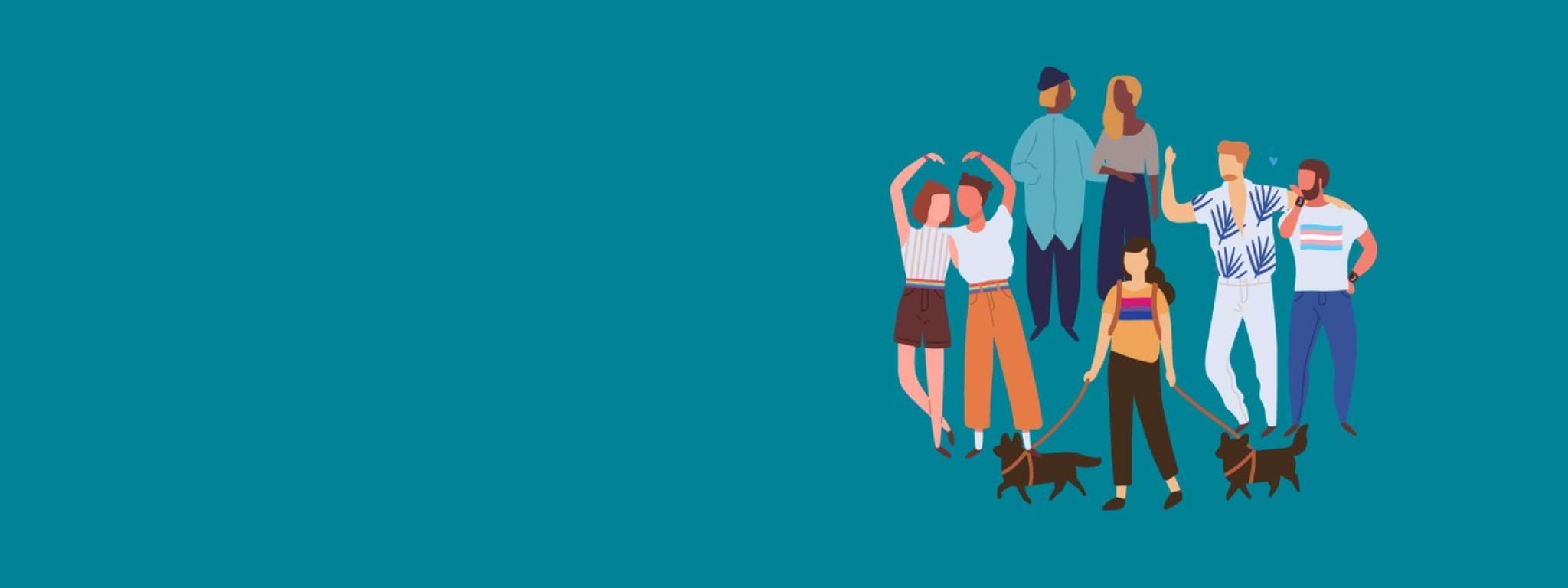While LGBTIQA+ communities take strength in shared pride, LGBTIQA+ people have their own unique experiences, practices and culture.
Our understanding of LGBTIQA+ communities has changed and will continue to evolve. In the past 10 years, involvement from the margins of rainbow communities has increased. The visibility, presence and voices of communities like LGBTIQA+ people of colour, LGBTIQA+ people of faith and trans and gender diverse people has increased. But, in many instances, increased visibility has increased experiences of discrimination. Over the next 10 years we will see an even greater community understanding of LGBTIQA+ communities and their diversity.
Just over one in 20 adult Victorians (5.7 per cent) openly identify as being LGBTIQA+1. It is difficult to know the exact number because of the different ways people feel attraction, how they behave and how they self-identify2. This can change over time and by age. The statistics in this strategy only tell part of the story and are a snapshot from a point in time.
It is important to recognise the diversity of LGBTIQA+ experiences. Being LGBTIQA+ is only one part of any person’s identity. As well as being diverse in their sexuality, gender identity or sex characteristics, LGBTIQA+ people are diverse in other ways. This might include their Aboriginality, ethnicity, colour, nationality, refugee or asylum seeker background, migration or visa status, language, faith, ability, age, mental health, socioeconomic status, housing status or geographic location. For example, LGBTIQA+ Victorians from ethnic faith communities experience life as LGBTIQA+, as well as being a person of colour and a person of faith. This is especially true for first-generation Australians who have unique journeys to identify with all aspects of themselves.
Many people within LGBTIQA+ communities who live with other forms of discrimination and inequality are less visible. For example, LGBTIQA+ people who are people of colour, asylum seekers, refugees, people of faith or sex workers and their respective experiences are less visible. They can also face discrimination from within LGBTIQA+ communities, as well as broader community stigma.
In delivering the LGBTIQA+ strategy, it is important that our actions recognise the different experiences within LGBTIQA+ communities. They must contribute to building a better picture of LGBTIQA+ life and needs.
‘When I came out in the 1990s, I came out as a lesbian because it was too hard to be bi… If I appear as bi+ then people start to question my relationship.’
Workshop participant, bi+ consultation
Definitions
Intersectionality This is an approach to understanding how social meanings related to the way we categorise and identify can overlap and interconnect. This creates different layers and types of discrimination or disadvantage for either an individual or group. Categories include gender, sexual orientation, sex characteristics, ethnicity, language, faith, class, socioeconomic status, ability and age.
Key statistics
- 1.8 per cent of Victorians identify as being lesbian or gay
- 2.8 per cent of Victorians identify as bisexual
- 1.1 per cent of Victorians identify as transgender, gender diverse, queer, pansexual, asexual or having an intersex variation
Source: VAHI 20201
Although the data and research on LGBTIQ+ Victorians is limited, there is an emerging evidence base offering insight into LGBTIQA+ lives and community experience:
- More Victorian adults aged 18 to 34 identify as LGBTIQA+ than other age groups
- LGBTIQA+ people are more likely to call metropolitan Melbourne home than rural and regional areas
- LGBTIQA+ people are just as likely to speak a language other than English at home
- LGBTIQA+ people are more likely to volunteer
- One-fifth of young LGBTQA+ people take part in an LGBTIQA+ group at school or university
- LGBTIQA+ people are more likely to use a mainstream health service that is LGBTIQA+ inclusive
- Most LGBTIQA+ people feel that taking part in LGBTIQ+ communities is a positive thing
- LGBTIQA+ people are more likely to have a bachelor’s degree or higher than the general population
Sources: VAHI 20201, Hill et al. 2021c3
Compared with the general population, significantly more LGBTIQA+ adult Victorians:
- were born in Australia
- are members of community groups
- are Aboriginal
- have a total household income of less than $40,000
Source: VAHI 20201
Compared with the general population, significantly fewer LGBTIQA+ adult Victorians:
- are married or live with a partner
- are covered by private health insurance
- are members of a sports team
Source: VAHI 20201
References
[1] Victorian Agency for Health Information (VAHI) 2020, The health and wellbeing of the lesbian, gay, bisexual, transgender, intersex and queer population in Victoria: findings from the Victorian Population Health Survey 2017, State of Victoria, Melbourne.
[2] Carman M, et al. 2020, Research matters: How many people are LGBTIQ?, Rainbow Health Victoria, Melbourne.
[3] Hill AO, et al. 2021c, Writing themselves in 4: the health and wellbeing of LGBTQA+ young people in Australia. Victoria summary report, Australian Research Centre in Sex, Health and Society, La Trobe University, Melbourne.
Updated

